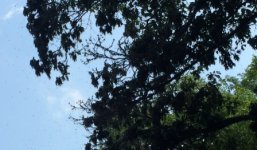pcray1231
Well-known member
No,
I was saying that all the bugs here that I see have 2 tails, not 3.
"Dark Green Drakes" (litobrancha recurvata) also have 2 tails, but hatch before the green drakes do, so I'm calling that unlikely. I know there was some hoopla about these bugs this year on Clark's Creek.
Brown drakes (ephemera simulans) hatch afterwards, but have 3 tails. These bugs have 2 tails. So they aren't brown drakes. Unless you saw a pic that I'm not seeing? (it is possible to have multiple bugs in the swarm)
Hence, these large mayflies are hatching in June, and they have 2 tails. They must be hexagenia.
As for exact species, probably hexagenia limbata as the timing is right and they are known to hatch on larger rivers in swarms like this, for instance on the Allegheny, and shut down bridges and such the same way. If they are new on the Susquehanna, well, congrats, but I bet this happens every year from now on out. They've been on the Allegheny where I grew up as long as I can remember, but I do recall around 2001 or so they started showing up in the city itself, which was "new" to the city folk, and caused a bit of a stir.
Possibly hexagenia bilineata. They look similar and can come off in equally impressive numbers, but in my experiences tend to happen in July. Whether timing would be the same on the Susquehanna I dunno, hence my uncertainty. You could make the argument that SC PA, in terms of hatches and other springtime natural cycles (like leaves, blooming, etc.), tends to be 2 weeks ahead of western PA. Hence limbata should be done and it's about the right time for bilineata.
Your hex hatch around the white fly time is probably hexagenia atrocaudata (aka the "Late Hex"). Same genus. Different species. I have not personally witnessed this hatch in any decent numbers, but have been told secondhand of largish hatches, for instance on Slippery Rock Creek.
"Hex" is not a single bug, it is a genus consisting of multiple bugs. Kinda like ephemera is a "drake" but there are green drakes, yellow drakes, brown drakes, etc. within that genus. (and the "dark green drakes" are actually much more closely related to hex's than drakes)
I was saying that all the bugs here that I see have 2 tails, not 3.
"Dark Green Drakes" (litobrancha recurvata) also have 2 tails, but hatch before the green drakes do, so I'm calling that unlikely. I know there was some hoopla about these bugs this year on Clark's Creek.
Brown drakes (ephemera simulans) hatch afterwards, but have 3 tails. These bugs have 2 tails. So they aren't brown drakes. Unless you saw a pic that I'm not seeing? (it is possible to have multiple bugs in the swarm)
Hence, these large mayflies are hatching in June, and they have 2 tails. They must be hexagenia.
As for exact species, probably hexagenia limbata as the timing is right and they are known to hatch on larger rivers in swarms like this, for instance on the Allegheny, and shut down bridges and such the same way. If they are new on the Susquehanna, well, congrats, but I bet this happens every year from now on out. They've been on the Allegheny where I grew up as long as I can remember, but I do recall around 2001 or so they started showing up in the city itself, which was "new" to the city folk, and caused a bit of a stir.
Possibly hexagenia bilineata. They look similar and can come off in equally impressive numbers, but in my experiences tend to happen in July. Whether timing would be the same on the Susquehanna I dunno, hence my uncertainty. You could make the argument that SC PA, in terms of hatches and other springtime natural cycles (like leaves, blooming, etc.), tends to be 2 weeks ahead of western PA. Hence limbata should be done and it's about the right time for bilineata.
Your hex hatch around the white fly time is probably hexagenia atrocaudata (aka the "Late Hex"). Same genus. Different species. I have not personally witnessed this hatch in any decent numbers, but have been told secondhand of largish hatches, for instance on Slippery Rock Creek.
"Hex" is not a single bug, it is a genus consisting of multiple bugs. Kinda like ephemera is a "drake" but there are green drakes, yellow drakes, brown drakes, etc. within that genus. (and the "dark green drakes" are actually much more closely related to hex's than drakes)







